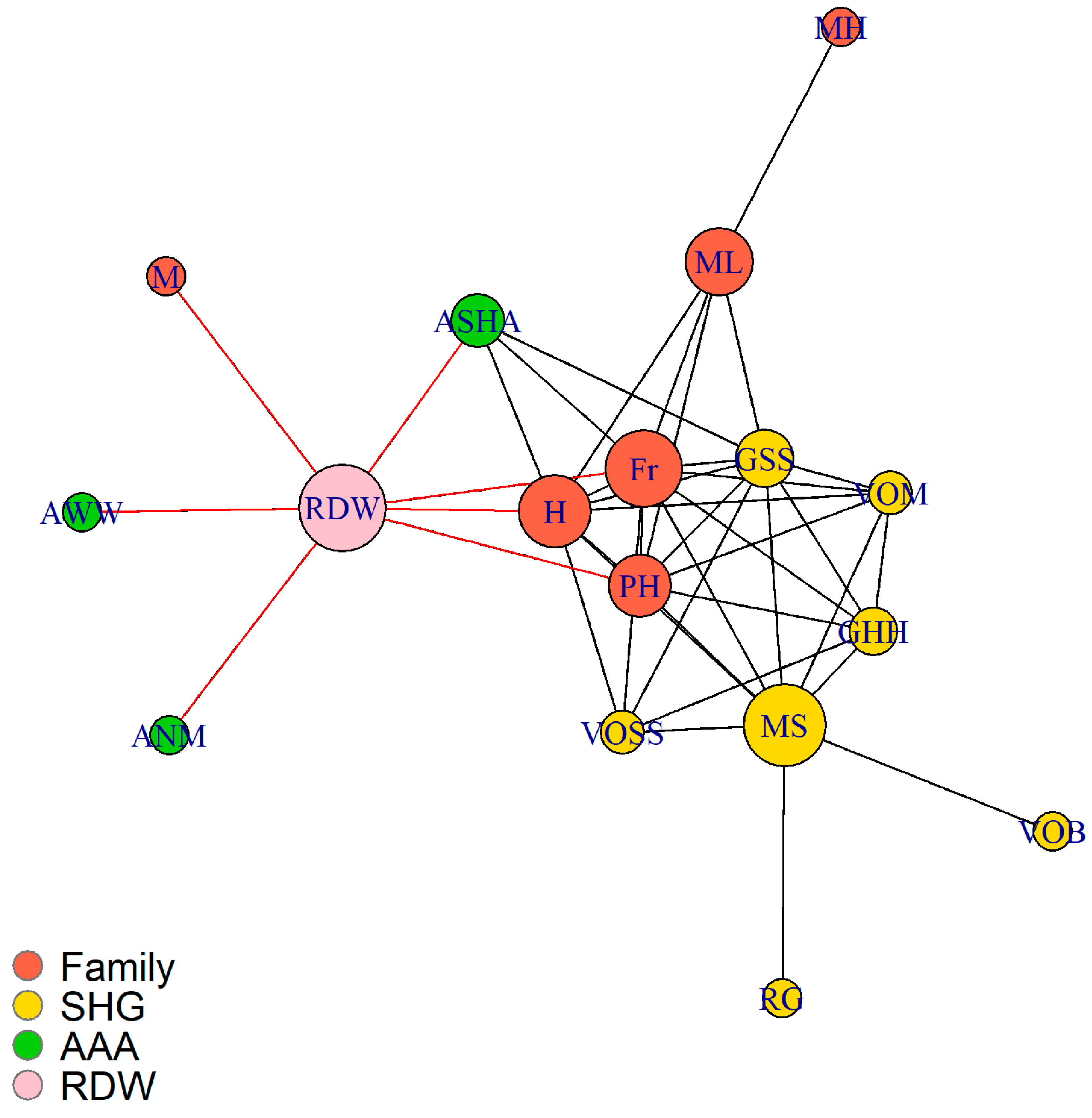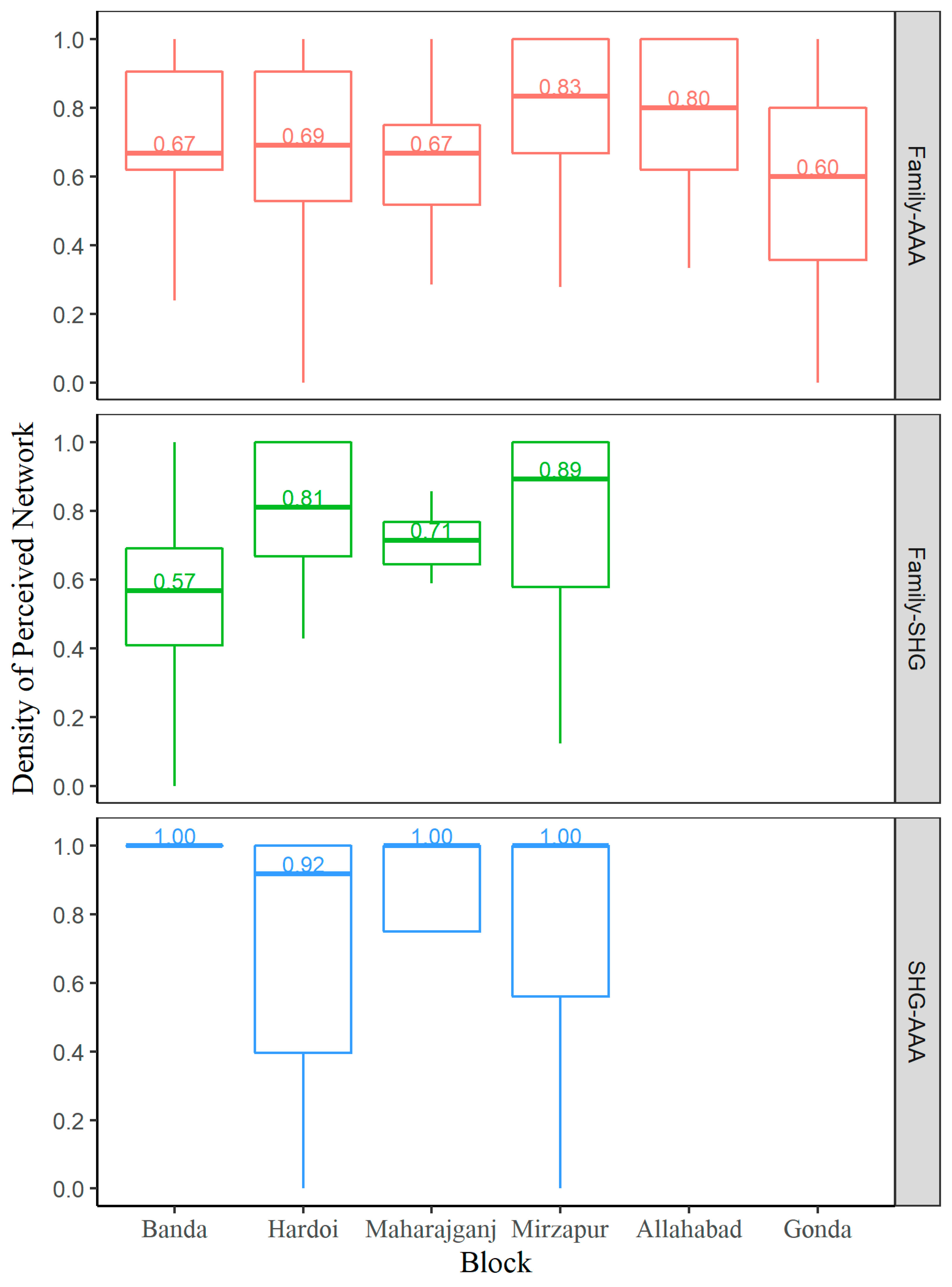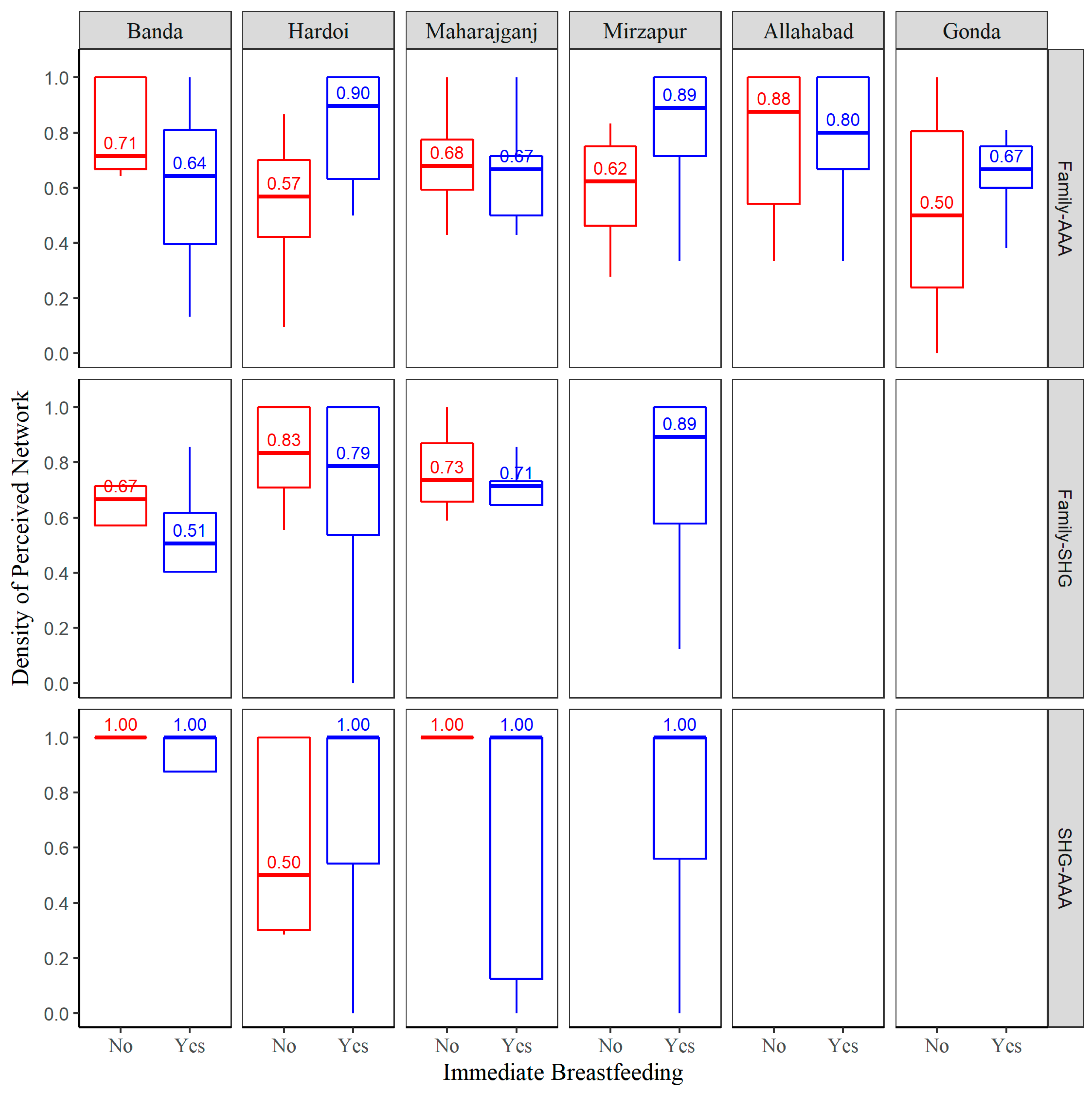Perceived Social Networks and Newborn Health: Evidence from Self-Help Group Communities in Northern India
Abstract
1. Introduction
1.1. Background and Study Purpose
1.2. Cognitive and Social Network Analysis
1.3. Self-Help Groups in India and Role of Social Capital
2. Materials and Methods
2.1. Study Population and Data Collection
2.2. Measures
2.3. Statistical Analysis
3. Results
3.1. First-Degree Networks
3.2. Perceived Networks
3.3. Application to Breast Feeding
4. Discussion
Author Contributions
Funding
Acknowledgments
Conflicts of Interest
References
- The Millennium Development Goals Report 2015. Available online: http://www.un.org/millenniumgoals/2015_MDG_Report/pdf/MDG%202015%20rev%20(July%201).pdf (accessed on 22 July 2018).
- Perkins, J.M.; Subramanian, S.V.; Christakis, N.A. Social networks and health: A systematic review of sociocentric network studies in low- and middle-income countries. Soc. Sci. Med. 2015, 125, 60–78. [Google Scholar] [CrossRef] [PubMed]
- Institute of Medicine (US) Committee on Assuring the Health of the Public in the 21st Century. 2, Understanding Population Health and Its Determinants. In The Future of the Public’s Health in the 21st Century; National Academies Press (US): Washington, DC, USA, 2002. [Google Scholar]
- Kincaid, D.L. Social networks, ideation, and contraceptive behavior in Bangladesh: A longitudinal analysis. Soc. Sci. Med. 2000, 50, 215–231. [Google Scholar] [CrossRef]
- Wölfer, R.; Scheithauer, H. Social influence and bullying behavior: Intervention-based network dynamics of the fairplayer.manual bullying prevention program. Aggress. Behav. 2014, 40, 309–319. [Google Scholar] [CrossRef] [PubMed]
- Prince, F. The relative effectiveness of a peer-led and adult-led smoking intervention program. Adolescence 1995, 30, 187–194. [Google Scholar] [PubMed]
- Albrecht, S.; Payne, L.; Stone, C.A.; Reynolds, M.D. A preliminary study of the use of peer support in smoking cessation programs for pregnant adolescents. J. Am. Acad. Nurse Pract. 1998, 10, 119–125. [Google Scholar] [CrossRef] [PubMed]
- Malchodi, C.S.; Oncken, C.; Dornelas, E.A.; Caramanica, L.; Gregonis, E.; Curry, S.L. The effects of peer counseling on smoking cessation and reduction. Obstet. Gynecol. 2003, 101, 504–510. [Google Scholar] [PubMed]
- Valente, T.W.; Ritt-Olson, A.; Stacy, A.; Unger, J.B.; Okamoto, J.; Sussman, S. Peer acceleration: Effects of a social network tailored substance abuse prevention program among high-risk adolescents. Addiction 2007, 102, 1804–1815. [Google Scholar] [CrossRef] [PubMed]
- Valente, T.W.; Saba, W.P. Mass Media and Interpersonal Influence in a Reproductive Health Communication Campaign in Bolivia. Commun. Res. 1998, 25, 96–124. [Google Scholar] [CrossRef]
- Latkin, C.A.; Donnell, D.; Metzger, D.; Sherman, S.; Aramrattna, A.; Davis-Vogel, A.; Quan, V.M.; Gandham, S.; Vongchak, T.; Perdue, T.; et al. The efficacy of a network intervention to reduce HIV risk behaviors among drug users and risk partners in Chiang Mai, Thailand and Philadelphia, USA. Soc. Sci. Med. 2009, 68, 740–748. [Google Scholar] [CrossRef] [PubMed]
- Morris, J.; Marzano, M.; Dandy, N.; O’Brien, L. Theories and Models of Behaviour and Behaviour Change. Forest Research, 2012. Available online: https://www.forestresearch.gov.uk/documents/1409/behaviour_review_theory.pdf (accessed on 23 July 2018).
- WHO and ExpandNet. Beginning with the End in Mind: Planning Pilot Projects and Other Programmatic Research for Successful Scaling Up. 2011. Available online: http://www.expandnet.net/PDFs/ExpandNet-WHO%20-%20Beginning%20with%20the%20end%20in%20mind%20-%202011.pdf (accessed on 22 July 2018).
- Reckwitz, A. Toward a Theory of Social Practices: A Development in Culturalist Theorizing. Eur. J. Soc. Theory 2002, 5, 243–263. [Google Scholar] [CrossRef]
- Ferlander, S. The Importance of Different Forms of Social Capital for Health. Acta Sociol. 2007, 50, 115–128. [Google Scholar] [CrossRef]
- Brands, R. Cognitive social structures in social network research: A review. J. Organ. Behav. 2013, 34, S82–S103. [Google Scholar] [CrossRef]
- Kilduff, M.; Crossland, C.; Tsai, W.; Krackhardt, D. Organizational network perceptions versus reality: A small world after all? Organ. Behav. Hum. Decis. Process. 2008, 107, 15–28. [Google Scholar] [CrossRef]
- Krackhardt, D.; Porter, L.W. The snowball effect: Turnover embedded in communication networks. J. Appl. Psychol. 1986, 71, 50–55. [Google Scholar] [CrossRef]
- Lewin, K. Field Theory in Social Science: Selected Theoretical Papers; Cartwright, D., Ed.; Harper & Brothers: New York, NY, USA, 1951. [Google Scholar]
- Newcomb, T.M. The Acquaintance Process; Holt Rinehart Winston: New York, NY, USA, 1961. [Google Scholar]
- Lakon, C.M.; Hipp, J.R. On Social and Cognitive Influences: Relating Adolescent Networks, Generalized Expectancies, and Adolescent Smoking. PLoS ONE 2014, 9, e115668. [Google Scholar] [CrossRef] [PubMed]
- Casciaro, T. Seeing things clearly: Social structure, personality, and accuracy in social network perception. Soc. Netw. 1998, 20, 331–351. [Google Scholar] [CrossRef]
- Ouellette, D. Shadows on the Cave Wall: The Cognitive Accuracy of Social Network Perception. Ph.D. Thesis, Virginia Commonwealth University, Richmond, VA, USA, 2008. [Google Scholar]
- Simpson, B.; Borch, C. Does Power Affect Perception in Social Networks? Two Arguments and an Experimental Test. Soc. Psychol. Q. 2005, 68, 278–287. [Google Scholar] [CrossRef]
- Stokes, J.P. The relation of social network and individual difference variables to loneliness. J. Pers. Soc. Psychol. 1985, 48, 981–990. [Google Scholar] [CrossRef]
- Ouellette, D. The Social Network and Attachment Bases of Loneliness. Master’s Thesis, Virginia Commonwealth University, Richmond, VA, USA, 2004. [Google Scholar]
- Deborah Messiana, N. Social Networking of Self Help Groups in Tribal Villages of Srikakulam District of Andhra Pradesh—A Critical Analysis. Ph.D. Thesis, Acharya N. G. Ranga Agricultural University, Hyderabad, India, 2012. [Google Scholar]
- Zaei, M.E.; Kapil, P.; Pelekh, O.; Teimoury Nasab, A. Does Micro-Credit Empower Women through Self-Help Groups? Evidence from Punjab, Northern India. Societies 2018, 8, 48. [Google Scholar] [CrossRef]
- Kaur, P. Efficiency of Microfinance Institutions in India: Are They Reaching the Poorest of the Poor? Vision 2016, 20, 54–65. [Google Scholar] [CrossRef]
- Tanggaard, A.K. Conceptualizing Organisational Domains of Community Empowerment through Empowerment Evaluation in Estonian Communities. Societies 2011, 1, 3–29. [Google Scholar]
- Banerjee, A.; Chandrasekhar, A.G.; Duflo, E.; Jackson, M.O. The diffusion of microfinance. Science 2013, 341, 1236498. [Google Scholar] [CrossRef] [PubMed]
- Allen, F.; Babus, A. Networks in Finance; SSRN Scholarly Paper ID 1094883; Social Science Research Network: Rochester, NY, USA, 2008. [Google Scholar]
- Freeman, L.C. The Sociological Concept of ‘Group’: An Empirical Test of Two Models. Am. J. Sociol. 1992, 98, 152–166. [Google Scholar] [CrossRef]
- Mitchell, C.U.; LaGory, M. Social Capital and Mental Distress in an Impoverished Community. City Community 2008, 1, 199–222. [Google Scholar] [CrossRef]
- Weitzman, E.R.; Kawachi, I. Giving means receiving: The protective effect of social capital on binge drinking on college campuses. Am. J. Public Health 2000, 90, 1936–1939. [Google Scholar] [PubMed]
- Rogers, E.M. Diffusion of Innovations; Free Press: New York, NY, USA, 2003. [Google Scholar]
- Burt, R.S. Political Disagreement: The Survival of Diverse Opinions within Communication Networks by Robert Huckfeldt, Paul E. Johnson, and John Sprague. Am. J. Sociol. 2006, 112, 310–312. [Google Scholar] [CrossRef]
- Baldassarri, D.; Gelman, A. Partisans without Constraint: Political Polarization and Trends in American Public Opinion. Am. J. Sociol. 2008, 114, 408–446. [Google Scholar] [CrossRef] [PubMed]
- Swain, R.B.; Wallentin, F.Y. Does microfinance empower women? Evidence from self-help groups in India. Int. Rev. Appl. Econ. 2009, 23, 541–556. [Google Scholar] [CrossRef]
- Leatherman, S.; Metcalfe, M.; Geissler, K.; Dunford, C. Integrating microfinance and health strategies: Examining the evidence to inform policy and practice. Health Policy Plan. 2012, 27, 85–101. [Google Scholar] [CrossRef] [PubMed]
- Malley, T.L.O.; Burke, J.G. A systematic review of microfinance and women’ s health literature: Directions for future research. AIDS Educ. Prev. 2014, 26, 13–27. [Google Scholar]
- Arrivillaga, M.; Salcedo, J.P. A systematic review of microfinance-based interventions for HIV/AIDS prevention. AIDS Educ. Prev. 2014, 26, 13–27. [Google Scholar] [CrossRef] [PubMed]



| Measures | Summary Statistics N = 185 |
|---|---|
| Demographic | |
| Sample size | 185 |
| Age, mean (SD) | 25.15 (4.46) |
| Literate, N (%) | 108 (58.4) |
| Received any education, N (%) | 111 (60.0) |
| Belong to scheduled caste/tribe, N (%) | 83 (44.9) |
| Residence | |
| Self-Help Group (SHG) Blocks & villages, N (%) | 120 (64.9) |
| Non-SHG Blocks & villages, N (%) | 65 (35.1) |
| SHG membership | |
| SHG members, N (%) | 36 (19.5) |
| Part of SHG network, N (%) | 51 (27.6) |
| Not SHG members, N (%) | 98 (53.0) |
| Heath outcome | |
| Immediate breastfeeding, N (%) | 107 (57.8) |
| Network measures | |
| Density, mean (SD) | 0.58 (0.18) |
| Knowing ties, mean (SD) | 10.43 (3.24) |
| Health advice ties, mean (SD) | 7.28 (4.07) |
| Affiliations | Knowing Ties | Health Advice Ties | Density of Health Advice |
|---|---|---|---|
| Family | 6.36 (0.96) | 4.14 (2.19) | 0.66 (0.34) a |
| SHG blocks | 6.41 (0.95) | 4.21 (2.25) | 0.66 (0.34) |
| Non-SHG blocks | 6.26 (0.99) | 4.00 (2.09) | 0.65 (0.34) |
| Health workers | 2.46 (0.96) | 1.91 (1.25) | 0.77 (0.38) |
| SHG blocks | 2.63 (0.83) b | 2.08 (1.18) b | 0.79 (0.36) |
| Non-SHG blocks | 2.17 (1.11) | 1.60 (1.32) | 0.73 (0.43) |
| SHG members | 2.48 (3.04) | 1.90 (2.63) | 0.76 (0.33) |
| Perceived Network | Pairs of Alters | Perceived Knowing Ties | Density of Perception |
|---|---|---|---|
| Family-Health workers | 16.30 (4.97) | 11.02 (5.48) | 0.68 (0.27) a |
| SHG blocks | 17.30 (4.53) | 11.94 (5.16) | 0.70 (0.25) |
| Non-SHG blocks | 14.14 (5.18) | 9.16 (5.69) | 0.64 (0.30) |
| Family-SHG members | 27.37 (19.09) | 18.40 (14.53) | 0.71 (0.28) |
| SHG members-Health workers | 12.43 (8.51) | 9.16 (2.63) | 0.77 (0.35) |
| Affiliations | Blocks | Knowing Ties, N (%) |
|---|---|---|
| ASHA | SHG blocks | |
| Banda | 20 (74.1) | |
| Hardoi | 28 (87.5) | |
| Maharajganj | 27 (90.0) | |
| Mirzapur | 22 (71.0) | |
| Non-SHG blocks | ||
| Allahabad | 14 (41.2) a | |
| Gonda | 23 (74.2) | |
| ANM | SHG blocks | |
| Banda | 20 (74.1) | |
| Hardoi | 21 (65.6) | |
| Maharajganj | 22 (73.3) | |
| Mirzapur | 19 (61.3) | |
| Non-SHG blocks | ||
| Allahabad | 15 (44.1) | |
| Gonda | 21 (67.7) |
| Blocks | Immediate Breastfeeding, N (%) |
|---|---|
| SHG blocks | 80 (66.7) a |
| Banda | 17 (63.0) |
| Hardoi | 18 (56.3) |
| Maharajganj | 18 (60.0) |
| Mirzapur | 27 (87.1) |
| Non-SHG blocks | 27 (41.5) |
| Allahabad | 17 (50.0) |
| Gonda | 10 (32.3) b |
© 2018 by the authors. Licensee MDPI, Basel, Switzerland. This article is an open access article distributed under the terms and conditions of the Creative Commons Attribution (CC BY) license (http://creativecommons.org/licenses/by/4.0/).
Share and Cite
Ruducha, J.; Huang, X.; Potter, J.; Hariharan, D.; Ahmad, D.; Kumar, S.; Mohanan, P.S.; Hazra, A. Perceived Social Networks and Newborn Health: Evidence from Self-Help Group Communities in Northern India. Societies 2018, 8, 92. https://doi.org/10.3390/soc8040092
Ruducha J, Huang X, Potter J, Hariharan D, Ahmad D, Kumar S, Mohanan PS, Hazra A. Perceived Social Networks and Newborn Health: Evidence from Self-Help Group Communities in Northern India. Societies. 2018; 8(4):92. https://doi.org/10.3390/soc8040092
Chicago/Turabian StyleRuducha, Jenny, Xinran Huang, James Potter, Divya Hariharan, Danish Ahmad, Sampath Kumar, P. S. Mohanan, and Avishek Hazra. 2018. "Perceived Social Networks and Newborn Health: Evidence from Self-Help Group Communities in Northern India" Societies 8, no. 4: 92. https://doi.org/10.3390/soc8040092
APA StyleRuducha, J., Huang, X., Potter, J., Hariharan, D., Ahmad, D., Kumar, S., Mohanan, P. S., & Hazra, A. (2018). Perceived Social Networks and Newborn Health: Evidence from Self-Help Group Communities in Northern India. Societies, 8(4), 92. https://doi.org/10.3390/soc8040092





